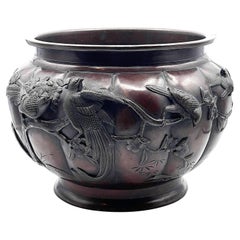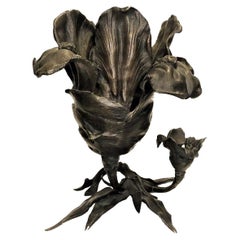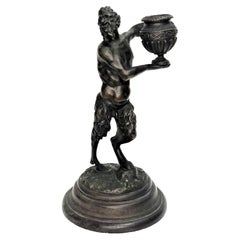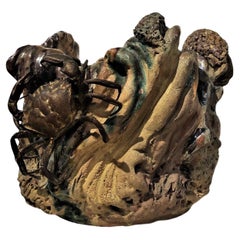Want more images or videos?
Request additional images or videos from the seller
1 of 8
Napoleon III Marble and Bronze Garniture, France, 19th Century
$1,800List Priceper set
About the Item
- Dimensions:Height: 14.75 in (37.47 cm)Diameter: 5.5 in (13.97 cm)
- Sold As:Set of 2
- Style:Napoleon III (Of the Period)
- Materials and Techniques:
- Place of Origin:
- Period:
- Date of Manufacture:circa 1860
- Condition:Wear consistent with age and use. We make our best effort to provide a fair and descriptive condition report. Please examine the photos attentively, as they are an integral part of the item description.
- Seller Location:New York, NY
- Reference Number:1stDibs: LU2819310157533
About the Seller
5.0
Gold Seller
Premium sellers maintaining a 4.3+ rating and 24-hour response times
Established in 1993
1stDibs seller since 2017
86 sales on 1stDibs
Typical response time: 8 hours
Authenticity Guarantee
In the unlikely event there’s an issue with an item’s authenticity, contact us within 1 year for a full refund. DetailsMoney-Back Guarantee
If your item is not as described, is damaged in transit, or does not arrive, contact us within 7 days for a full refund. Details24-Hour Cancellation
You have a 24-hour grace period in which to reconsider your purchase, with no questions asked.Vetted Professional Sellers
Our world-class sellers must adhere to strict standards for service and quality, maintaining the integrity of our listings.Price-Match Guarantee
If you find that a seller listed the same item for a lower price elsewhere, we’ll match it.Trusted Global Delivery
Our best-in-class carrier network provides specialized shipping options worldwide, including custom delivery.You May Also Like
19th Century French Napoleon III Period Bronze Centerpiece on Marble Base
Located in Dallas, TX
An exceptional 19th century French Napoleon III period bronze centerpiece on marble base depicts Bacchus and Ariadne in full relief, plus an intriguing dragon's tail handle on each s...
Category
Antique Late 19th Century French Napoleon III Urns
Materials
Marble, Bronze
$1,998
H 6.5 in W 15.5 in D 10.5 in
Pair Of Marble And Gilded Bronze Cassolettes, Napoleon III, 19th Century
Located in MARSEILLE, FR
Elegant pair of green marble cassolettes with white veins, richly decorated with gilded bronze: lids with pine cones, side handles depicting rams' heads, openwork friezes of scrolls ...
Category
Antique Mid-19th Century French Napoleon III Urns
Materials
Marble, Bronze
$7,791 / set
H 13.39 in W 10.63 in D 7.88 in
Pair Of Large Bronze And Marble Cassolettes, Napoleon III, 19th Century
Located in MARSEILLE, FR
Pair of large green marble cassolettes with rich gilt bronze ornamentation: knots, garlands of flowers and leaves, putti raising their arms towards the flame on the lid (socket)
Aft...
Category
Antique 19th Century French Napoleon III Urns
Materials
Marble, Bronze
$16,183 / set
H 27.96 in W 15.36 in D 11.42 in
French 19th Century Napoleon III Period Marble, Ormolu and Bronze Garniture Set
Located in West Palm Beach, FL
A handsome and high quality French 19th century Napoleon III period black Belgian marble, ormolu and patinated bronze garniture set. The three pi...
Category
Antique 19th Century French Napoleon III Mantel Clocks
Materials
Belgian Black Marble, Bronze, Ormolu
$19,800 / set
H 28.5 in W 15.25 in D 12 in
Gilt-Bronze and Cloisonné Garniture. France, 19th Century
Located in Buenos Aires, Buenos Aires
Gilt-bronze and cloisonné garniture, France, 19th century.
Clock works.
Category
Antique Late 19th Century French Louis XVI Table Clocks and Desk Clocks
Materials
Bronze, Enamel
$20,000 / set
H 17.33 in W 22.84 in D 5.91 in
19th Century French Napoleon III Burl Walnut Marquetry and Bronze Plant Stand
Located in Dallas, TX
Decorate a room with this elegant antique jardinière. Created in France circa 1870, and oval in shape, the planter stands on cabriole legs decorated with acanthus leaf motifs at the ...
Category
Antique Mid-19th Century French Napoleon III Planters, Cachepots and Jar...
Materials
Bronze
$2,100
H 33 in W 23 in D 16.5 in
Pair of 19th Century French Napoleon III Period Bronze & Brass Urns
Located in Dallas, TX
Pair of 19th Century French Napoleon III Period Bronze & Brass Urns represent the mastery of metal sculpture exhibited by the French during this wonderful era and are of a nice size ...
Category
Antique 1870s French Napoleon III Urns
Materials
Belgian Black Marble, Brass, Bronze
$3,024 Sale Price / set
20% Off
H 13 in W 8.5 in D 6 in
19th Century French Napoleon III Ormolu & White Marble Urns, circa 1850
Located in Royal Tunbridge Wells, Kent
Antique Mid-19th century French Ormolu mounted on white marble urns on green marble bases.
CONDITION
In Great Condition - No Damage.
Size
Height: 36cm
Width: 15.5cm
Depth: ...
Category
Antique 19th Century French Napoleon III Urns
Materials
Marble, Ormolu
$7,133 / set
Free Shipping
H 14.18 in W 6.11 in D 6.11 in
AMAZING GARNITURE SÉVRES 19th Century Napoleon III
Located in Madrid, ES
GARNITURE SÉVRES 19th Century Napoleon III
French,
composed of a clock and a pair of seven-light candelabra, in cobalt blue Sévres style pocella.
C...
Category
Antique 19th Century French Napoleon III Table Clocks and Desk Clocks
Materials
Bronze
Pair of French 19th Century Napoleon III St. Patinated Bronze and Ormolu Tazzas
Located in West Palm Beach, FL
A wonderful and charming true pair of French 19th century Napoleon III st. patinated bronze and ormolu tazzas. Each tazza is raised by a square ormolu base with concave corners and a...
Category
Antique 19th Century French Napoleon III Urns
Materials
Ormolu, Bronze
$7,600 / set
H 12.25 in W 7.5 in D 7.5 in
More From This Seller
View AllJapanese Edo Period Bronze Jardinière w/ Birds & Cherry Blossom Tree, 19th C.
Located in New York, NY
#350
Japanese Edo Period Bronze Jardinière w/ Birds & Cherry Blossom Tree, 19th C.
DIMENSIONS:
Height: 9 inches
Diameter: 12 inches
DETAILS
Edo Period (1603-1868) Meiji Period (...
Category
Antique Mid-19th Century Japanese Japonisme Planters, Cachepots and Jard...
Materials
Bronze
French Art Nouveau Patinated Bronze Sculptural Iris Vase, ca. 1900
Located in New York, NY
ABOUT IRIS
The iris is a special and mysterious flower. Not only because of its striking appearance, but also from an artistic and historical point of view. It is also like a work of art, as though created by Mother Nature. The unique leaves of this plant not only create wonderful shadow casts, but also look as if they were painted by hand. It's no wonder that iris acts as the muse for countless artists, and can be seen in many famous works of art.
The iris was first spotted in the time of Pharaoh Thutmose, in 1504 BC. He had the iris inscribed into the wall reliefs of a temple as a sign of his power, as well as decorating his sceptre with motifs of the flower. Since then, the iris has been a symbol of victory in Egypt. But the symbolism of the iris goes further than that. In Japan, the flower represents courage and is the symbol of the boys' festival. In Islamic cultures, the iris is a symbol of prosperity. In Europe, the flower was a popular weapon symbol in the Middle Ages and stood for chivalry. And in Christianity, the iris was seen as a symbol of the trinity because of its three-part flowers. With more than 300 varieties, the iris is now the most popular flower among growers and gardeners following the rose.
Countless artists use the iris in their works and the flower is present in all eras. You can see the flower on furniture, vases, jewelry, fabrics, sculptures, coats of arms and much more. Did you know that the iris is also called the sword lily? It's not a coincidence that it used to symbolize physical and emotional pain and suffering caused by a weapon. We also see the flower in religious art, where it's often associated with Mary and Jesus. The iris is also associated with the Greek goddess Iris, where the flower symbolizes reconciliation and divine messages. This is also reflected in many paintings.
Finally, the iris is also visible in Dutch and Flemish still-life paintings. This can be in a religious form, incorporated into an object or as a decorative flower.
In the Art Nouveau art movement, the iris (along with other plants, such as the birch) was often used as an expression of feminine beauty. With its almost otherworldly appearance, the iris is perfectly suited to the Art Nouveau aesthetic and is featured in many well-known works of art. The poet of that era, Hermann Hesse...
Category
Antique Early 1900s French Art Nouveau Planters, Cachepots and Jardinières
Materials
Bronze
Antique Continental Patinated Bronze Fawn Candlestick, 19th Century
Located in New York, NY
Probably Italian, 19th Century patinated bronze candlestick in form of a dancing Fawn holding a candle-vessel in his hands, on its original wood base.
Category
Antique 1880s Italian Belle Époque Figurative Sculptures
Materials
Bronze
French Art Nouveau Iridescent Stoneware & Bronze Vase or Cachepot, ca. 1900s
Located in New York, NY
French Art Nouveau
Ocean Life Theme
Vase Cachepot
Iridescent Stoneware & Patinated Bronze Crab Appliqué
ca. 1900s
ABOUT
We present here a most unusual and utterly decorative Fren...
Category
Antique Early 1900s French Art Nouveau Vases
Materials
Stoneware
A 19th Century Japanese Signed Bronze Tiger Sculpture, Circa 1860s
Located in New York, NY
19th Century Japan
Tiger
Bronze Sculpture
Circa 1860s
DIMENSIONS
Tiger with base is 33" L x 21" H x 21" D
The bronze tiger is 28" L x 15" H
ABOUT
A finely cast bronze sculpture of a...
Category
Antique 1860s Japanese Japonisme Animal Sculptures
Materials
Bronze
A Pair of Bronze Neoclassical Grand Tour Candelabras, Late 19th Century
Located in New York, NY
Grand Tour
Pair of Bronze Candelabras
Late 19th Century
DIMENSIONS
Height: 10.33 inches
Width: 4.75 inches
Depth: 4.75 inches
ABOUT
We present to your attention a pair of stunning...
Category
Antique 1890s English Grand Tour Candelabras
Materials
Bronze
Recently Viewed
View AllMore Ways To Browse
French Antique Urn
French Urns 19th Century
Antique Bronze Urns
French Antique Vases Urns
Antique Marble Vases
Black Urn
Antique Porcelain Urn
Gold Urn Vase
Antique Bronze Vases And Urns
19th Century French Porcelain Urns
White Urn
Pairs Of Bronze Urns
Pair Of Marble Vases
French Marble Urns
Antique Black Urn
Antique Decorative Urns
Pair Marble And Bronze Urns
Urn With Handles



